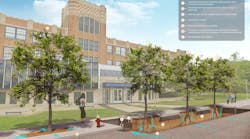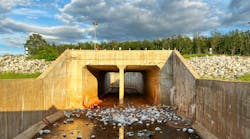Lehigh University involved in multiple LID stormwater projects
Y.C. Ethan Yang, a civil and environmental engineer working on issues at the food-water-energy nexus, is working with Lehigh University on multiple projects to help communities embrace stormwater infrastructure.
Building a "smart," resilient campus
A group of Lehigh undergraduate students are working with Yang on a stormwater mitigation project designed to help the campus achieve one of the goals outlined in Lehigh's Sustainability Strategic Plan 2030: develop a Stormwater Management Plan (SMP) by the end of 2021 that identifies green infrastructure and low-impact development (LID) projects, and provides guidelines for the design team to help mitigate stormwater runoff impacts and treat rainwater as a resource rather than as a waste product.The students and Yang will work toward upgrading the existing green infrastructure on campus, such as several water retention basins designed to collect rainwater and delay its release into the city's drainage system. Their first project aims to achieve a better understanding of the effectiveness of the water retention basin on Lehigh's Goodman campus. Step one is to install several "smart" sensors at the facility in order to obtain real-time measurements. This will have the additional benefit of testing the custom sensors that Yang and the students are building.
"Our idea is: so, we have these basins, but we don't really know how they function, how much water they collect, how long they can delay the stormwater drainage and how much water we should be releasing for maximum impact," says Yang. "We won't know these details unless we install our sensors up there to do the measuring."
Some of the students will be working on the project as part of the Campus Sustainable Impact Fellowship, a partnership between the Office of Creative Inquiry and the Office of Sustainability to provide students with hands-on experiential learning through campus sustainability projects. Part of the 2030 strategic plan is to utilize the campus as a living laboratory to advance campus sustainability.
Sustainability is at the heart of Yang's efforts, and the frameworks he builds are designed to provide the information that institutions and governments need to determine how best to upgrade existing facilities to improve their resilience.
Adds Yang: "Our team wants to ask them: Are you thinking about upgrading the facilities that you have now in order to improve their resiliency and reliability? Maybe an event won't happen for the next 20 or 50 years, but it's a risk management issue. Are you willing to invest in something now to prevent future problems?"
Urban flooding: too much water all at once
Yang and a team of researchers are also working with Bethlehem Township, Pa., the most flood-prone municipality in the Lehigh Valley region, on a framework to help mitigate urban flooding. This work could become a model for other municipalities in the region and across the country. The project, funded by an NSF CAREER Award, is in its first of five years.
According to a recent report by the Center for Disaster Resilience at the University of Maryland, flooding caused by excessive stormwater runoff in developed areas where the water doesn't have anywhere to go is widespread and costly—and, perhaps, an even greater challenge than extreme flooding events.
"The reason we have these stormwater flooding issues is not because we don't have drainage systems—we do," says Yang. "The problem is that too much water is coming down at the same time and our system cannot handle it. So, the solution is actually to try to delay that timing a little bit to avoid flooding."
Bethlehem Township's government is looking to do just that. Part of that effort is a program to encourage homeowners to implement low-cost measures such as rain barrels and rain gardens. While the Township looks to implement a stormwater fee to residents and issue credits to those who undertake mitigation efforts, Yang and his team will survey and interview local residents to assess their willingness to participate in such a program in exchange for reduced stormwater fees.
"Sometimes the models show good results, but the most challenging part is convincing people to take action," says Yang.
Yang will use an agent-based modeling approach to simulate both the natural process of how rainfall generates runoff and the location of potential flood zones within the township, as well as property owners' behavior in order to design a flood mitigation program that works.


